ANALYSIS OF ACCESSIBILITY AND EXPERIENCE OF SPECIAL FORCES- STYLE TOURISM - TAKING WUHAN EAST LAKE AS AN EXAMPLE
DOI:
https://doi.org/10.71411/jassp.2025.487Keywords:
Special forces-style tourism, Behavioural accessibility;, Experiential analysis;, Wuhan East lakeAbstract
This study examines spatial experiences and perceived accessibility among young participants in “Special Forces-style tourism,” a high-intensity, time-compressed travel style prevalent among Chinese youth. Using Wuhan East Lake Scenic Area as a case study, data from 150 valid questionnaires were analyzed through descriptive statistics, correlation analysis, and multiple regression to explore relationships among behavioral patterns, spatial accessibility, and experience satisfaction. Results indicate that young tourists exhibit distinct behaviors, prioritizing efficiency, visual consumption, and frequent movement. Satisfaction with natural and cultural landscapes significantly predicted overall experience satisfaction, whereas clarity of internal signage and spatial accessibility had limited statistical influence, suggesting adaptive behaviors under tight schedules. Notably, external transportation convenience was negatively correlated with satisfaction, reflecting tensions between urban infrastructure and perceived crowding or time pressure. This research contributes to debates on youth travel behavior and urban tourism spatial design, highlighting the mediating role of perceived accessibility in high-intensity tourism experiences. The study calls for a nuanced understanding of youth-driven tourism patterns and for spatial strategies that respond to evolving behaviors.
References
Chang, J. H., & Lee, C.-H. (2023). The effect of real-time crowding information on tourists’ procrastination of planned travel schedule. Journal of Hospitality and Tourism Management. https://doi.org/10.1016/j.jhtm.2023.06.001 DOI: https://doi.org/10.1016/j.jhtm.2023.06.001
Chuangxin, L., Meng, L., & Dongxue, H. (2024). Mental dilemmas and escape compensation: A study on the formation pathways of “Special Forces-style Tourism” behavior. ECOTOURISM, 14(5), Article 5. https://doi.org/10.12342/zgstly.20240096
Ding, K., Yin, Z., Zhang, X., He, Y., & Jia, Y. (2024). Study on the Influencing Factors of College Students’ Willingness to Engage in Special Forces-Style Tourism Based on Structural Equation Model. Operations Research and Fuzziology, 14, 34. https://doi.org/10.12677/orf.2024.144373 DOI: https://doi.org/10.12677/orf.2024.144373
Guo, J. (2023). The underlying subcultural influence of “special forces-style tourism.” PR Magazine, 51–52.
Lepetiuk, V., Tretyak, V., & Maksymova, Y. (2023). The use of GIS technologies to determine transport accessibility in tourism. Geodesy and Cartography, 49(3), Article 3. https://doi.org/10.3846/gac.2023.17009 DOI: https://doi.org/10.3846/gac.2023.17009
LI, F. (2023). A Look at the Popular Phenomenon of “Special Forces-Style Tourism” from the Perspective of Communication Studies. Journalism and Communications, 11, 711. https://doi.org/10.12677/JC.2023.114107 DOI: https://doi.org/10.12677/JC.2023.114107
Maio, A. D., Musmanno, R., & Skrame, A. (2023). An Urban-Scale Application of the Problem of Designing Green Tourist Trips with Time Windows. 203–219. https://doi.org/10.1007/978-3-031-49662-2_11 DOI: https://doi.org/10.1007/978-3-031-49662-2_11
Mieli, M., Zillinger, M., & Nilsson, J.-H. (2024). Phygital time geography, or: What about technology in tourists’ space-time behaviour? Tourism Geographies, 26, 389–406. https://doi.org/10.1080/14616688.2024.2318722 DOI: https://doi.org/10.1080/14616688.2024.2318722
Sanbao, Z., & Kexin, L. I. (2024). Special Forces-Style Tourism: Characteristics, Antecedents and Effects. Tourism and Hospitality Prospects, 8(5), 27. https://doi.org/10.12054/lydk.bisu.279
Seyfi, S., Hall, M. C., Saarinen, J., Zaman, M., & Vo‐Thanh, T. (2024). Identifying constraints on Gen Z’s path toward ethical tourism consumption and practices. Journal of Sustainable Tourism, 33, 1216–1234. https://doi.org/10.1080/09669582.2024.2418967 DOI: https://doi.org/10.1080/09669582.2024.2418967
Siegel, L. A., Tussyadiah, I., & Scarles, C. (2023). Exploring behaviors of social media-induced tourists and the use of behavioral interventions as salient destination response strategy. Journal of Destination Marketing & Management, 27, 100765. https://doi.org/10.1016/j.jdmm.2023.100765 DOI: https://doi.org/10.1016/j.jdmm.2023.100765
Talal, M. L., & Santelmann, M. V. (2021). Visitor access, use, and desired improvements in urban parks. Urban Forestry & Urban Greening, 63, 127216. https://doi.org/10.1016/j.ufug.2021.127216 DOI: https://doi.org/10.1016/j.ufug.2021.127216
Ye, J., & Wang, Y. (2024). People on the Run: The Paradox of Youth Seeking Spatiotemporal Perception and Its Countermeasures—Taking “Special-Forces-Style Tourism” as an Example. Ideological & Theoretical Education, 04, 105–111.
Yu, J., & Wang, S. (2024). Special Forces Tourism: A Perspective on College Students’ Possessive Experience Consumption in the Digital Era. Chinese Youth Studies, 5, 94–101. https://doi.org/doi:10.19633/j.cnki.11-2579/d.2024.0064.
Zhou, H., & Wu, J. (2024). A Value Review on Youth Special Forces Style Tourism. Journal of Changzhou University (Social Science Edition), 06, 109–116. https://doi.org/CNKI:SUN:JSSB.0.2024-06-010
Downloads
Published
Issue
Section
License
Copyright (c) 2025 Zhang Peng, Nadia Binti Mohd Nasir (Author)

This work is licensed under a Creative Commons Attribution 4.0 International License.











